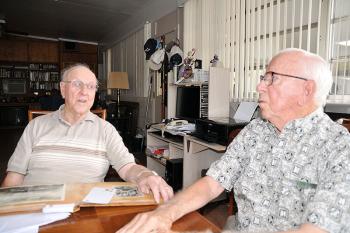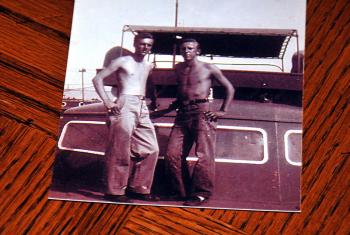
Richard Romaire, left, and Ferris Romaire talk Wednesday about their military service during World War II while at Richard Romaire’s home in Morgan City.
--The Daily Review/Photos by Zachary Fitzgerald

From left, Richard Romaire and Ferris Romaire are seen in January 1946 next to the air-sea rescue boat Ferris Romaire served on when the brothers met in Manila, Philippines, after World War II ended.

Richard Romaire is pictured at the bottom far right with his B-29 bomber crew at Rattlesnake Air Force Base in Pecos, Texas.
Brothers reflect on WWII service, meeting in Philippines after war
MORGAN CITY — Though Richard Romaire and Ferris Romaire served thousands of miles apart during World War II, the brothers reunited after the war ended when both were stationed in the Philippines.
Richard Romaire, 89, and Ferris Romaire, 88, both of Morgan City, first moved to the city in 1938.
Richard Romaire was commissioned as a navigator in the Air Force in 1944 and then attended radar school. “After radar school, we were assigned to B-29s, and we trained as a crew at Rattlesnake Bomber Base in Pecos, Texas,” he said. The B-29 Richard Romaire served on was called “Dangerous Lady.”
As a radar specialist, Richard Romaire helped the navigator guide planes through bad weather. During World War II, he was stationed on the island of Tinian in the Northern Mariana Islands. “It was the largest airfield in the world at that time,” Richard Romaire said.
“We were flying to Tinian when the war ended in Europe. We were almost to Hawaii when they declared peace over there,” Richard Romaire said. He flew 15 missions during the war. “The second to last mission we flew we bombed the rail yards. As we were turning to come back to the base, we flew pretty close to Hiroshima, and we were able to see all the devastation,” he said.
Ferris Romaire was stationed in the U.S. during World War II. He joined the Navy in May 1944, three days after graduating high school, and was sent to boot camp in Hitchcock, Texas. He then traveled to Camp Pendleton in California and next to San Diego Destroyer Base.
“Then from there they wanted volunteers to go to Moffett Field in San Francisco, volunteered for that. Then they wanted volunteers to go to Alameda Naval Air Station, volunteered for that,” he said. “Then they wanted volunteers to go to Tillamook, Oregon, volunteered for that.”
Ferris Romaire served at the blimp base in Tillamook, Ore., doing submarine surveillance, he said. “I volunteered for everything,” he said.
Ferris Romaire was assigned to a rear admiral’s air-sea rescue named “Alfred” boat that was stationed at Sangley Point directly across from Manila, Philippines. Eventually, he became the skipper of the boat. “How I got to be the skipper of that boat to this day I don’t know,” Ferris Romaire said.
After the end of the war, Richard Romaire flew from Tinian to the 38th Parallel in North Korea passing over the Shimonoseki Strait, he said. “When we did, there were ships upside down on end up all over the place. So the mining really helped to stop the war because they couldn’t get no supplies,” he said.
Air force personnel would drop 2,000-pound mines that would blow up enemy vessels, Richard Romaire said. The brothers both were stationed in the Philippines after the war ended and met up in January 1946. Richard Romaire worked as a salvage officer in Manila and met Ferris Romaire there.
Richard Romaire left the Air Force in August 1946 while Ferris Romaire was discharged in June 1946.
Richard Romaire was called back to the Air Force when the Korean War began. He served as a radar instructor in San Antonio.
Though he did not know it at the time, during World War II, Richard Romaire was stationed a mere few hundred yards from where one of the atomic bombs was loaded to be dropped on Japan, he said.
His longest flight in the service was a 19-hour trip from Tinian to the 38th Parallel in North Korea, Richard Romaire said.
“That plane, B-29, was built especially to bomb Japan because they had such a long flight that the B-17s, B-24s couldn’t fly to that distance,” Ferris Romaire said.
Richard Romaire achieved the rank of major in the Air Force when he retired from military service. “There were a lot of wonderful experiences and a lot of bad ones,” he said.
Ferris Romaire achieved the rank of coxswain.
Before the brothers joined the military, they attended school in Morgan City.
Richard Romaire graduated as the 1941 valedictorian of Sacred Heart High School, and Ferris Romaire graduated from Morgan City High School in 1944. Richard Romaire has been married to his wife Marian for nearly 70 years while Ferris Romaire has been married to his wife Margaret for almost 68 years.
Ferris Romaire started working at E.J. Fields Machine Works in Morgan City in 1946 for 65 cents an hour. “That’s when the oil industry was first starting in Morgan City,” he said.
Richard Romaire returned to Morgan City after his brother. He studied engineering in college and knew how machines worked. So Richard Romaire went to work for E.J. Fields, he said.
Richard Romaire bought E.J. Fields Machine Works and owned it for about 20 years though Ferris Romaire was running the business much of the time, Richard Romaire said. Richard Romaire’s children now own the business.
Richard Romaire lives right behind E.J. Fields Machine Works located on Front Street. “There was an old wooden shop right there, and we built this metal building that you see right there,” Ferris Romaire said. “Then, from there, we built that shop underneath the bridge.”
Reflecting on his service in the Air Force, Richard Romaire said, “If I had to do it all over again, I’d do it the same damn way.”
- Log in to post comments
